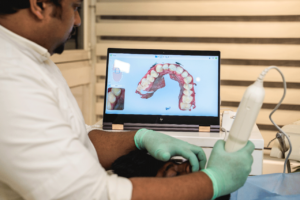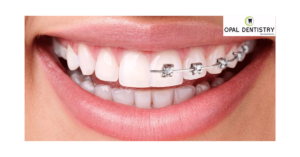Introduction:
When it comes to orthodontic treatment for your child, two popular options often come to mind: Invisalign and metal braces. Both aim to straighten teeth and improve oral health, but they differ in various aspects. In this article, we will explore the differences between Invisalign and metal braces and help you make an informed decision about which treatment is the best choice for your child.


Table of Contents:
- Understanding Invisalign and Metal Braces
- Aesthetics: Invisalign vs Metal Braces
- Comfort and Convenience: Invisalign vs Metal Braces
- Effectiveness: Invisalign vs Metal Braces
- Maintenance and Oral Hygiene: Invisalign vs Metal Braces
- Treatment Duration: Invisalign vs Metal Braces
- Cost Considerations: Invisalign vs Metal Braces
- Choosing the Best Option for Your Child
- Conclusion
Understanding Invisalign and Metal Braces:
Before we delve into a detailed comparison, let’s briefly understand what Invisalign and metal braces are.
Invisalign: Invisalign is a popular orthodontic treatment that uses clear aligners made of a smooth, BPA-free plastic. These aligners are custom-made to fit your child’s teeth and gradually shift them into their correct positions.
Metal Braces: Metal braces, on the other hand, consist of metal brackets bonded to the teeth and connected with wires. They work by applying pressure to the teeth, gradually moving them to their desired positions.
Aesthetics: Invisalign vs Metal Braces:
One significant advantage of Invisalign is its virtually invisible appearance. The clear aligners are discreet, allowing your child to smile and speak with confidence. Metal braces, on the other hand, are more noticeable due to their visible brackets and wires. If your child is concerned about the impact of orthodontic treatment on their appearance, Invisalign may be the preferable choice.
Comfort and Convenience: Invisalign vs Metal Braces:
When it comes to comfort, Invisalign aligners have an edge over metal braces. The smooth plastic aligners are custom-made to fit snugly over your child’s teeth, minimizing discomfort and irritation. Metal braces, on the other hand, may cause some discomfort due to the brackets and wires rubbing against the soft tissues of the mouth. Adjustments and occasional tightening of metal braces can also lead to temporary discomfort.
In terms of convenience, Invisalign offers more flexibility. The aligners can be easily removed during meals, allowing your child to enjoy their favorite foods without restrictions. They can also be removed for special occasions or when playing sports. Metal braces, being fixed appliances, require more caution with food choices and may limit certain activities.
Effectiveness: Invisalign vs Metal Braces:
Both Invisalign and metal braces are effective at straightening teeth, but the severity of your child’s orthodontic issues may play a role in determining the most suitable treatment.
Invisalign: Invisalign is highly effective and versatile used for treating mild, moderate and severe orthodontic problems, such as overcrowding, gaps, and complex bite issues. The end result can be artificially simulated using 3D technology and pre-visioned during treatment planning stage.
Metal Braces: Metal braces are versatile and can effectively address various orthodontic concerns, including severe crowding, complex bite problems, and tooth rotation.
Maintenance and Oral Hygiene: Invisalign vs Metal Braces:
Maintaining good oral hygiene is crucial during orthodontic treatment. Here’s how Invisalign and metal braces compare in terms of maintenance and oral hygiene:
Invisalign: The aligners are removable, making oral hygiene maintenance easier. Your child can brush and floss their teeth as they would normally, without any obstructions. Cleaning the aligners themselves is also simple using the provided cleaning solutions.
Metal Braces: Metal braces require extra care and attention. Food particles can easily get trapped in the brackets and wires, increasing the risk of plaque buildup and tooth decay. Special brushes and techniques are required to clean around the brackets, and regular dental check-ups are necessary to ensure optimal oral health.
Treatment Duration: Invisalign vs Metal Braces:
The duration of orthodontic treatment varies depending on your child’s specific needs and the complexity of their case. However, generally speaking:
Invisalign: Treatment duration with Invisalign can be shorter compared to metal braces, especially for mild to moderate cases. Your child will need to wear the aligners for 20-22 hours a day and switch to a new set every 1-2 weeks.
Metal Braces: Metal braces typically require a longer treatment duration. The average treatment time is around 18-24 months, although it can be shorter or longer based on individual circumstances. Regular adjustments are needed to achieve the desired results.
Cost Considerations: Invisalign vs Metal Braces:
Cost is an important factor to consider when choosing an orthodontic treatment. While the exact cost varies depending on several factors such as location and complexity of the case, metal braces are generally more affordable than Invisalign.
Invisalign aligners tend to be more expensive due to their advanced technology and customized approach. However, it’s essential to consult with an orthodontist to get an accurate estimate based on your child’s specific needs.
Choosing the Best Option for Your Child:
When deciding between Invisalign and metal braces, consider the following factors:
- The severity of your child’s orthodontic issues.
- Your child’s aesthetic concerns and comfort preferences.
- Lifestyle factors, such as dietary habits and participation in sports.
- Financial considerations.
Consulting with an experienced orthodontist is crucial as they can assess your child’s specific needs and provide personalized recommendations.
Conclusion:
Invisalign and metal braces are both effective orthodontic treatments that can help your child achieve a healthy and confident smile. Invisalign offers discreet aesthetics, greater comfort, and convenience, while metal braces provide versatility and precise control over tooth movement. Consider your child’s specific requirements, preferences, and the advice of an orthodontist to make an informed decision. Remember, the most important outcome is a healthy and beautiful smile for your child, regardless of the treatment option you choose.
Table: Comparison of Invisalign and Metal Braces
| Aspect | Invisalign | Metal Braces |
| Aesthetics | Virtually invisible | Noticeable brackets and wires |
| Comfort | Smooth aligners, minimal discomfort | Discomfort and irritation initially |
| Convenience | Removable aligners, no food restrictions | Fixed appliances, dietary restrictions |
| Effectiveness | Mild to moderate cases | Mild to severe cases |
| Maintenance | Easy oral hygiene maintenance | Special care required, risk of plaque buildup |
| Treatment Duration | Shorter treatment time for mild to moderate | Longer treatment time, regular adjustments |
| Cost | Generally more expensive | Generally more affordable |
Remember; consult with an orthodontist for personalized advice and treatment recommendations for your child.
Note: The information provided in this article is for educational purposes only and should not be considered as professional medical advice. Please consult with an orthodontist for accurate diagnosis and personalized treatment options.